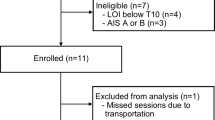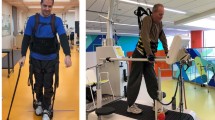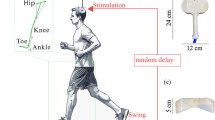Abstract
Objective:
Maximum toe elevation during walking is an objective measure of foot drop and reflects the impairment of the corticospinal tract (CST) in persons with spinal cord injury (SCI). To determine if this measurement is functionally relevant to ambulatory abilities, we correlated maximum toe elevation with clinical physiotherapy tests.
Setting:
Cross-sectional study, laboratory and clinical settings.
Methods:
A total of 24 individuals with SCI (American Spinal Injury Association (ASIA) Impairment Scale D) were recruited. Maximum toe elevation during the swing phase of treadmill gait was measured with a kinematic system. CST function was assessed in a sitting position by measuring the motor-evoked potentials (MEPs) induced in tibialis anterior muscle with transcranial magnetic stimulation over the motor cortex. Clinical tests performed were 10-m and 6-min walk test (6MWT), Timed-Up and Go (TUG), Walking Index for Spinal Cord Injury, Berg Balance Scale, Lower Extremity Motor Score (LEMS) and sensory score of the L4, L5 and S1 dermatomes.
Results:
Participants with lower toe elevation during gait walked at a slower speed, took more time to perform the TUG test, and covered a shorter distance in the 6MWT. They also scored lower on the LEMS and showed impaired superficial sensitivity of the dermatomes around the ankles. Few correlations were observed between CST function and clinical tests, but the presence of MEP at rest was indicative of faster speed and longer distance in the 6MWT.
Conclusion:
These results indicate that maximum toe elevation, which is directly correlated with CST impairment, is functionally relevant as it also correlates with timed clinical tests, LEMS and sensory scores.
Similar content being viewed by others
Log in or create a free account to read this content
Gain free access to this article, as well as selected content from this journal and more on nature.com
or
References
Thomas SL, Gorassini MA . Increases in corticospinal tract function by treadmill training after incomplete spinal cord injury. J Neurophysiol 2005; 94: 2844–2855.
Piron L, Piccione F, Tonin P, Dam M . Clinical correlation between motor evoked potentials and gait recovery in poststroke patients. Arch Phys Med Rehabil 2005; 86: 1874–1878.
Curt A, Keck ME, Dietz V . Functional outcome following spinal cord injury: significance of motor-evoked potentials and ASIA scores. Arch Phys Med Rehabil 1998; 79: 81–86.
Wirth B, van Hedel HJ, Curt A . Ankle paresis in incomplete spinal cord injury: relation to corticospinal conductivity and ambulatory capacity. J Clin Neurophysiol 2008; 25: 210–217.
Nathan PW . Effects on movement of surgical incisions into the human spinal cord. Brain 1994; 117 (Pt 2): 337–346.
Calancie B, Alexeeva N, Broton JG, Suys S, Hall A, Klose KJ . Distribution and latency of muscle responses to transcranial magnetic stimulation of motor cortex after spinal cord injury in humans. J Neurotrauma 1999; 16: 49–67.
Westhout FD, Pare LS, Linskey ME . Central causes of foot drop: rare and underappreciated differential diagnoses. J Spinal Cord Med 2007; 30: 62–66.
Barthelemy D, Willerslev-Olsen M, Lundell H, Conway BA, Knudsen H, Biering-Sorensen F et al. Impaired transmission in the corticospinal tract and gait disability in spinal cord injured persons. J Neurophysiol 2010; 104: 1167–1176.
Kirshblum SC, Burns SP, Biering-Sorensen F, Donovan W, Graves DE, Jha A et al. International standards for neurological classification of spinal cord injury (revised 2011). J Spinal Cord Med 2011; 34: 535–546.
Ditunno JF Jr, Barbeau H, Dobkin BH, Elashoff R, Harkema S, Marino RJ et al. Validity of the walking scale for spinal cord injury and other domains of function in a multicenter clinical trial. Neurorehabil Neural Repair 2007; 21: 539–550.
van Hedel HJ, Wirz M, Dietz V . Assessing walking ability in subjects with spinal cord injury: validity and reliability of 3 walking tests. Arch Phys Med Rehabil 2005; 86: 190–196.
Ditunno JF, Scivoletto G, Patrick M, Biering-Sorensen F, Abel R, Marino R . Validation of the walking index for spinal cord injury in a US and European clinical population. Spinal Cord 2008; 46: 181–188.
Wirz M, Muller R, Bastiaenen C . Falls in persons with spinal cord injury: validity and reliability of the Berg Balance Scale. Neurorehabil Neural Repair 2010; 24: 70–77.
Lemay JF, Nadeau S . Standing balance assessment in ASIA D paraplegic and tetraplegic participants: concurrent validity of the Berg Balance Scale. Spinal Cord 2010; 48: 245–250.
Newstead AH, Hinman MR, Tomberlin JA . Reliability of the Berg Balance Scale and balance master limits of stability tests for individuals with brain injury. J Neurol Phys Ther 2005; 29: 18–23.
van Hedel HJ, Wirz M, Dietz V . Standardized assessment of walking capacity after spinal cord injury: the European network approach. Neurol Res 2008; 30: 61–73.
Bensoussan L, Mesure S, Viton JM, Delarque A . Kinematic and kinetic asymmetries in hemiplegic patients' gait initiation patterns. J Rehabil Med 2006; 38: 287–294.
Chin R, Hsiao-Wecksler ET, Loth E, Kogler G, Manwaring SD, Tyson SN et al. A pneumatic power harvesting ankle-foot orthosis to prevent foot-drop. J Neuroeng Rehabil 2009; 6: 19.
Weber DJ, Stein RB, Chan KM, Loeb GE, Richmond FJ, Rolf R et al. Functional electrical stimulation using microstimulators to correct foot drop: a case study. Can J Physiol Pharmacol 2004; 82: 784–792.
Novak AC, Olney SJ, Bagg S, Brouwer B . Gait changes following botulinum toxin A treatment in stroke. Top Stroke Rehabil 2009; 16: 367–376.
Paoloni M, Mangone M, Scettri P, Procaccianti R, Cometa A, Santilli V . Segmental muscle vibration improves walking in chronic stroke patients with foot drop: a randomized controlled trial. Neurorehabil Neural Repair 2009; 24: 254–262.
Perez MA, Lungholt BK, Nyborg K, Nielsen JB . Motor skill training induces changes in the excitability of the leg cortical area in healthy humans. Exp Brain Res 2004; 159: 197–205.
Chen R, Classen J, Gerloff C, Celnik P, Wassermann EM, Hallett M et al. Depression of motor cortex excitability by low-frequency transcranial magnetic stimulation. Neurology 1997; 48: 1398–1403.
Mansur CG, Fregni F, Boggio PS, Riberto M, Gallucci-Neto J, Santos CM et al. A sham stimulation-controlled trial of rTMS of the unaffected hemisphere in stroke patients. Neurology 2005; 64: 1802–1804.
Belci M, Catley M, Husain M, Frankel HL, Davey NJ . Magnetic brain stimulation can improve clinical outcome in incomplete spinal cord injured patients. Spinal Cord 2004; 42: 417–419.
Acknowledgements
This research was supported by Canadian Institutes of Health Research, Danish National Research Foundation, Elsass Foundation and Bevica Foundation. Dorothy Barthélemy is a member of the Multidisciplinary sensorimotor rehabilitation research team (www.errsm.ca) supported by the CIHR and the Quebec-Ontario spinal cord injury mobility (SCI-Mob) research group funded by the Quebec Rehabilitation Research network (REPAR) and the Ontario Neurotrauma Foundation (ONF).
Author information
Authors and Affiliations
Corresponding author
Ethics declarations
Competing interests
The authors declare no conflict of interest.
Rights and permissions
About this article
Cite this article
Barthélemy, D., Knudsen, H., Willerslev-Olsen, M. et al. Functional implications of corticospinal tract impairment on gait after spinal cord injury. Spinal Cord 51, 852–856 (2013). https://doi.org/10.1038/sc.2013.84
Received:
Revised:
Accepted:
Published:
Issue date:
DOI: https://doi.org/10.1038/sc.2013.84
Keywords
This article is cited by
-
Contribution of corticospinal drive to ankle plantar flexor muscle activation during gait in adults with cerebral palsy
Experimental Brain Research (2019)



